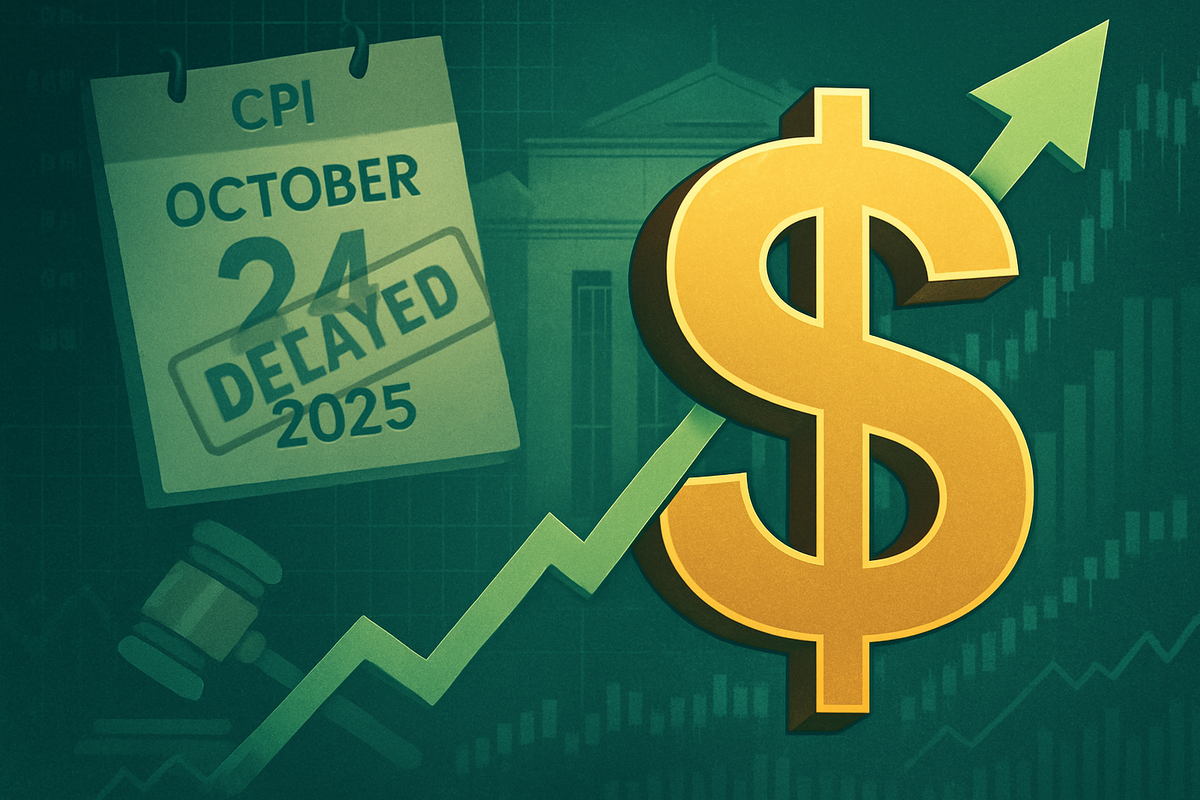
Washington D.C., October 22, 2025 – Financial markets are buzzing with anticipation as bullish signals for the U.S. dollar gain momentum, all while awaiting the crucial release of a delayed Consumer Price Index (CPI) report. This confluence of events is setting the stage for potentially significant shifts in Federal Reserve monetary policy, with immediate and profound implications for interest rates, asset valuations, and global economic stability. The market is bracing for a critical period, as the incoming inflation data will heavily influence the Fed's next moves, particularly concerning its dual mandate of price stability and maximum employment.
The U.S. dollar's recent resurgence, evidenced by a robust bounce in the U.S. Dollar Index (DXY) above 98.60, indicates a renewed confidence in the greenback. This strength comes despite earlier banking sector concerns, bolstered by easing trade tensions and expectations of a resolution to the ongoing government shutdown. Meanwhile, the delayed September CPI report, now slated for release on Friday, October 24, 2025, looms large. Originally scheduled for October 15, its postponement due to the shutdown means the Federal Reserve will receive this vital inflation gauge just days before its highly anticipated Federal Open Market Committee (FOMC) meeting on October 28-29. Market consensus forecasts are pointing towards an acceleration in both headline and core CPI to 3.1% year-over-year, a figure that, if realized, would remain stubbornly above the Fed's 2% target.
A Tense Countdown to Inflation Data and Fed Action
The current market dynamics are shaped by a series of interconnected events and expectations. The bullish sentiment surrounding the U.S. dollar is multifaceted. A hawkish repricing in the USD Overnight Index Swap (OIS) curve suggests that market participants are anticipating a less aggressive stance on future rate cuts, or even a pause, from the Federal Reserve. This policy divergence is further amplified by other major central banks, such as the Bank of Canada, which are more readily expected to implement rate cuts, thereby enhancing the dollar's relative attractiveness.
The timeline leading up to this moment has been punctuated by the U.S. government shutdown, which not only delayed the CPI report but also other critical economic indicators like the monthly jobs report. This delay has created a period of heightened uncertainty, forcing investors to operate with incomplete information regarding the true state of inflation. The Bureau of Labor Statistics (BLS) is now under intense scrutiny as the financial world awaits its official figures. Key players in this unfolding drama include the Federal Reserve, led by its Chairman, whose statements and decisions will be meticulously dissected; institutional investors, who are constantly adjusting their portfolios based on macroeconomic signals; and government officials, whose fiscal policies and resolutions to issues like shutdowns directly impact market sentiment. Initial market reactions have been mixed: gold prices have retreated significantly, reflecting the stronger dollar and profit-taking, while U.S. equities (e.g., Dow Jones Industrial Average (NYSE: DJIA)) have shown resilience, partly due to eased credit market concerns and robust earnings reports. However, the policy-sensitive 2-year Treasury yield has eased, reflecting a strong market expectation of a Fed rate cut despite the dollar's strength.
Corporate Winners and Losers in a Shifting Rate Environment
The potential actions of the Federal Reserve and the trajectory of interest rates, heavily influenced by the upcoming CPI data, will undoubtedly create distinct winners and losers among public companies. A stronger dollar and potentially higher-for-longer interest rates could have varied impacts across sectors.
Companies with significant international operations that repatriate earnings in foreign currencies, such as multinational technology giants like Apple (NASDAQ: AAPL) or Microsoft (NASDAQ: MSFT), might see their overseas profits diminish when converted back to a stronger U.S. dollar. Conversely, companies that primarily operate domestically and source their inputs locally could benefit from reduced import costs if a stronger dollar makes foreign goods cheaper. Financial institutions, particularly large banks like JPMorgan Chase (NYSE: JPM) and Bank of America (NYSE: BAC), often thrive in a rising interest rate environment as their net interest margins—the difference between what they earn on loans and pay on deposits—tend to expand. However, an environment of slowing economic growth, even with higher rates, could temper loan demand and increase default risks. Retailers and consumer discretionary companies, such as Amazon (NASDAQ: AMZN) or Target (NYSE: TGT), might face headwinds if higher interest rates lead to increased borrowing costs for consumers and businesses, potentially dampening consumer spending and investment. Furthermore, companies with substantial debt, especially those with variable-rate loans, could see their interest expenses rise significantly, impacting profitability. Conversely, companies with strong balance sheets and low debt, or those that generate significant free cash flow, will be better positioned to weather higher borrowing costs.
Broader Implications and Historical Parallels
This scenario of a strong dollar and anticipated Fed action amidst inflation concerns is not isolated but fits into broader industry trends of monetary policy tightening cycles and currency fluctuations. The potential for the Federal Reserve to prioritize employment stability over immediate inflation targeting, despite a 3.1% CPI forecast, highlights a shift in its reactive framework. This could have ripple effects on global competitors and partners, particularly emerging markets whose dollar-denominated debts become more expensive to service with a stronger greenback. Countries heavily reliant on exports to the U.S. might also see their goods become less competitive.
Regulatory or policy implications could include increased scrutiny on the Fed's independence, especially if external pressures for aggressive rate cuts persist. Historically, periods of strong dollar appreciation have often coincided with capital outflows from emerging markets and increased pressure on commodity prices. For instance, comparing this to the early 1980s, when the Fed aggressively raised rates to combat inflation, or the late 1990s, when a strong dollar impacted U.S. export competitiveness, provides valuable context. While the specifics differ, the underlying tension between inflation control, economic growth, and currency strength remains a recurring theme in financial history. The current situation also underscores the delicate balance central banks must strike, particularly in a globalized economy where domestic policy decisions have international ramifications.
Navigating the Path Ahead: Short-Term Volatility, Long-Term Adjustments
The immediate future promises continued volatility as markets digest the delayed CPI data and anticipate the Federal Reserve's decision. In the short term, if the CPI report indeed comes in hotter than expected at 3.1%, it could trigger a further strengthening of the U.S. dollar and a reassessment of the Fed's commitment to a rate cut. While a 25-basis-point cut at the October 28-29 meeting appears largely priced in, a surprisingly high CPI could temper expectations for subsequent cuts in December and beyond.
Potential strategic pivots for businesses might include focusing on domestic markets, hedging against currency fluctuations for international operations, and rigorously managing debt portfolios. Market opportunities could emerge in sectors traditionally favored during periods of higher interest rates, such as financials, or in companies with strong pricing power that can pass on increased costs to consumers. Challenges will undoubtedly include increased borrowing costs for expansion and potential softening of consumer demand. Several scenarios could unfold: the Fed could proceed with the expected cut, signaling a prioritization of employment despite inflation; it could cut rates but issue a hawkish statement, indicating a slower pace of future cuts; or, in a less likely but more disruptive scenario, a significantly hotter CPI could lead to a postponement of the cut, which would send shockwaves through the market.
Market Outlook: Awaiting Clarity Amidst Shifting Sands
In summary, the confluence of bullish dollar signals and the impending, delayed CPI release has created a critical juncture for financial markets. The Federal Reserve's decisions in the coming days and weeks will be paramount, as it navigates the complex interplay between persistent inflation, a softening labor market, and a strengthening currency. The market's current expectation of a 25-basis-point rate cut at the October meeting reflects a belief that the Fed is prioritizing employment stability, but a hotter-than-expected CPI could force a re-evaluation of this path.
Moving forward, investors should closely monitor not only the official CPI release and the Fed's subsequent statement but also the nuances of their forward guidance. Key takeaways include the dollar's renewed strength, the market's strong conviction for a near-term rate cut, and the significant uncertainty surrounding the inflation trajectory. The lasting impact of these events will depend on whether the Fed can successfully engineer a "soft landing" – bringing inflation under control without triggering a severe recession. What investors should watch for in the coming months are further inflation data, employment reports, and any shifts in the Fed's communication regarding its dual mandate. The path ahead remains uncertain, but the next few days will provide crucial clarity.
This content is intended for informational purposes only and is not financial advice





